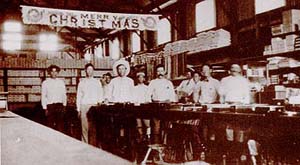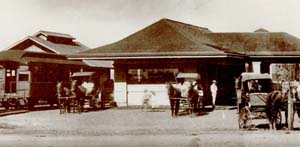PA'IA
The town of Pa'a was fabricated from water and sugar. In 1878, water from the newly completed Hamakua Ditch turned large tracts of land at the Alexander and Baldwin Plantation in East Maui into fields of vigorous sugar cane. In order to process the resulting crops, the plantation built a mill at Pa'ia in 1880, thereby creating a community where little had existed before.
In 1903, the profitable sugar operation, by then renamed the Pa'ia Plantation, merged with its sister Ha'iku Sugar Company to form the Maui Agricultural Company. Three years later the newly organized company built a larger, improved Pa'ia mill. From its inception until 1946, Harry A. Baldwin presided over Maui Agricultural Company. Baldwin was also president of several other firms, a member of the Territorial Senate for many years, and served as Hawai'i's delegate to Congress in 1922. On his death, the county dedicated a Pa'ia-area beach park in his memory.
Upper Pa'ia, site of the mill, burgeoned with plantation camps housing mill and field workers of every ethnic background. Several camps clustered around the mill, while others fanned out beyond Pa'ia. In the town's heyday in the 1930's and 1940's, most of Pa'ia's population of more than 10,000 leved in Upper Pa'ia, shopped at the Pa'ia Store and smaller outlying camp stores, frequented Nashiwa Bakery, and enjoyed movies and amateur contests at the Orpheum and Pa'ia theaters. The company run Pa'ia Store was no small-time operation! Clerks throughout the rambling two-story building sold just about everything - groceries, hardware, dry goods, clothing, and furniture, while mechanics repaired ailing automobiles and soda jerks dispensed fountain refreshments to the thirsty.

Exterior view of the company-owned Pa'ia Store, 1930's.
This gigantic store was one of many that served
the town's 10,000 residents.

Sprecklesville Mill at the completion of its construction, 1892
In contrast to Upper Pa'ia, the plantation did not own the land of Lower Pa'ia. Private entrepreneurs served primarily plantation clientele through a vast number of retail businesses - stores, meat and fish markets, restaurants and bars, service stations, barber shops, photo studios, and small Japanese hotels. Several theaters amused the populace over time, including the Lower Pa'ia and Princess theaters.
Pa'ia was a self-contained world. Its citizens enjoyed their own library and gym and sent their children to Pa'ia School, the largest on Maui. To entertain themselves, some cheered on barbed birds at cockfights, while others attended Japanese plays called shibais. Nearly all participated in a diversity of sports programs and attended on of several Buddhist, Shinto, Protestant, and Catholic churches in the area. Pa'ia Hospital later used as Maui Children's Home, cared for the sick and injured.
A massive fire in 1930 destroyed 15 stores and several other structures in Lower Pa'ia, requiring a portion of the town to be rebuilt. Disaster struck again in 1946, when a tsunami heavily damaged the community. However devastating, the effects of these tragedies were relatively short-lived. On the other hand, the residential development of Kahului in the 1950's, which lured thousands of sugar workers away with the prospect of owning their own homes, had a long-lasting deleterious effect on Pa'ia's prosperity.
The Maui Agricultural Company merged with the Hawaiian Commercial & Sugar Company in 1948, under which name the Pa'ia mill still grinds cane. Although the retail buildings in Pa'ia remain, almost all are filled with buisinesses catering to tourists and newcomers, particularly the large numbers of windsurfers that permeate the community. The residential camps are gone, and only a few Pa'ia plantation-era stores, such as the Pa'ia Clothes Cleaners, and Nagata and Horiuchi stores, survive as reminders of Pa'ia as it once was, a large and bustling sugar town.

Harry A. Baldwin, Maui Agricultural Company manager, with wife Ethel, 1922. At this time Baldwin was Hawai'i's delegate to Congress, having been elected upon the death of Prince Kuhio.

Possibly the first ambulance on isle, purchased for use at Maui Agricultural Company's Pa'ia Hospital in 1912.

Pa'ia School lunch token, 1915-1935, good for a five-cent lunch. The hole in the center allowed the token to be secured on a string around the neck.

Inside view of early Pa'ia Store,
destroyed by fire in 1910.

The corner of Hana Highway and
Baldwin Avenue, Lower Pa'ia, circa 1920,
showing some of Lower Pa'ia's numerous
privately owned businesses.

Pa'ia railroad depot around 1910. Kahului Railroad
transported both sugar and passengers
to and from upper Pa'ia after tracks
were laid in 1905.
|
